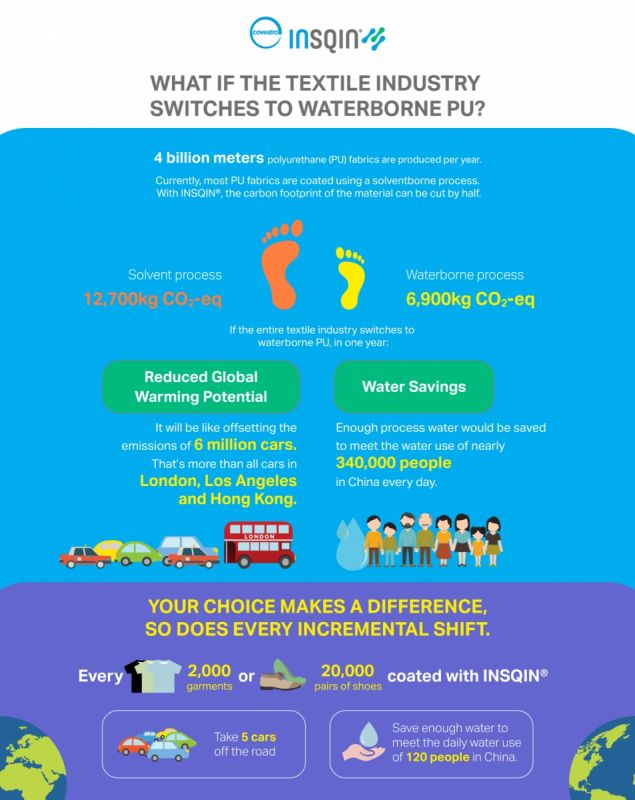Reducing Textile Water Use by 95% with PU
Published on by Water Network Research, Official research team of The Water Network in Business
A recent life-cycle assessment (LCA) of a waterborne polyurethane (PU) technology created by high-tech polymer company Covestro and dubbed INSQIN® has been found to reduce the carbon footprint of textile coating by 45% compared to conventional solvent-based technology.
“The LCA provides an extra layer of assurance in the environmental performance of INSQIN. It shows brands that this technology can help them reach their sustainability targets. Achievements in carbon footprint reduction will be important to not only fashion and sportswear brands, but also the automotive and furniture industries,” said Nick Smith, Global Head of Textiles and Coatings at Covestro.
The study compared a comprehensive range of parameters to assess the environmental performance of waterborne PU from the extraction of raw materials to coated fabric production versus that of the conventional technology, which involves the use of the solvent dimethylformamide (DMF).

According to the results of the LCA, 1,000 square meters of PU synthetic made with INSQIN has a Global Warming Potential of 6,900 kilograms CO2-eq, compared to 12,7000 kilograms CO2-eq in the case of solvent-based PU leather.
The impact of this reduction is enough that if the entire textile industry switched to using this waterborne PU technology, the reduction of greenhouse gas emissions would be equivalent to taking every car off the road in Beijing, or in London, Hong Kong and Los Angeles combined.
Eighty-five percent of INSQIN’s Global Warming Potential is due to the lower energy consumption of the dry textile coating process that is enabled by the waterborne PU and that replaces conventional wet processing. Essentially, the benefit of the technology lies in the process changes it makes possible.
Using INSQIN to coat textiles with PU also has the potential to reduce acidification of water and soil resources by 20 percent compared to conventional options.
The technology also boasts benefits in terms of water consumption, using 95 percent less process water than traditional technologies. If the entire textile industry were to employ INSQIN, enough water would be saved every day to meet the daily water use of nearly 340,000 people in China.
And now, the bad news.
Despite the growing popularity of using scrap textiles to bolster industry circularity initiatives, China has banned the import of textiles scraps under the guise of reducing pollution. The move has inspired pushback from the Institute of Scrap Recycling Industries (ISRI), who has filed a complaint with the World Trade Organization (WTO).
According to the ISRI, such a move could impede progress on global textile recycling and prevent China’s manufacturing sector from accessing valuable recyclable materials and minimize other opportunities for recycling.
Source: Sustainable Brands
Media
Taxonomy
- Textile
- Water Footprint
- Fibers & Textiles
- Textile